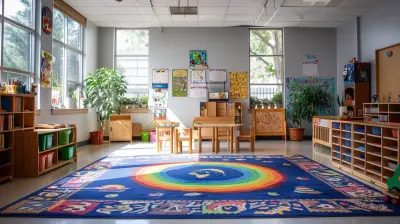11 September 2025
Have you ever met someone who seems endlessly curious? The kind of person who lights up at new ideas, who asks questions like a child seeing the world for the first time? That’s the magic of lifelong learning — it’s not just about schooling or ticking boxes on a curriculum checklist. It’s about nurturing an inner flame that keeps burning, long after the classroom lights go out.
In today’s fast-changing world, being a lifelong learner isn’t just a "nice-to-have" trait—it’s a survival skill. So how do we, as educators, parents, or mentors, fan that flame of curiosity in students and teach them to love learning for its own sake?
Let’s dive into the art and science of encouraging lifelong learning and building self-motivated students who see learning as a passion, not a chore.
The Beauty of Lifelong Learning
Lifelong learning is a mindset. It’s the idea that education doesn’t end with a diploma. It’s a journey, not a destination. From coding to cooking, from philosophy to photography — the learning never stops.But here’s the catch: you can’t force this journey. You can only invite, inspire, and guide. The moment learning becomes just "one more thing to do," the spark dims. That’s why nurturing self-motivation is the key.
Why Self-Motivation Matters More Than Ever
Let’s face it: external rewards only go so far. Grades, trophies, praise — they work for a while. But what happens when the carrot disappears? That’s when intrinsic motivation—the inner drive—has to take the wheel.When students are self-motivated, they:
- Take ownership of their learning
- Seek feedback to grow
- Bounce back from setbacks
- Set their own goals and chase them
Imagine a student reading about ancient civilizations not for a test, but because they’re truly fascinated by the echoes of the past. That’s the goal.
1. Create a Safe Space to Be Curious
First things first — curiosity doesn’t bloom in fear. If students are too worried about being wrong or judged, they’ll shut down faster than a scared turtle. So, how do we open them up?- Encourage questions, especially the wild ones.
- Celebrate mistakes as signs of trying.
- Share your own learning struggles. (Yes, even that time you bombed your math test.)
The more we humanize learning, the more students feel safe to explore.
🌱 Remember: A curious mind is like a garden — give it sunlight, water, and patience, and it will grow beyond imagination.
2. Ignite Passion Through Purpose
Let’s be real. Not all topics are thrilling to every student. (Lookin’ at you, algebra.) But purpose can make even the driest subjects meaningful.Ask this little magic question: “Why does this matter to you?”
When students connect learning to their dreams, interests, or even current real-world issues, learning becomes alive.
- A student into video games? Tie in storytelling, coding, or design.
- Someone who adores animals? Bring in zoology, environmental science, or ethics.
The bridge between boring and brilliant is relevance.
3. Offer Choice — Even If It’s Small
Nothing kills motivation like feeling trapped. Students light up when they get choices, even tiny ones.- Choose their book in a reading assignment
- Pick a topic for a project
- Decide how to present their findings — video, poster, podcast?
When students feel in control, they become co-pilots in their own learning journey. And co-pilots don’t just sit there — they help steer the course.
4. Show That Learning Doesn’t Live in Textbooks
One of the biggest myths? That learning only happens within four walls and a strict schedule. Nope.Learning is in the recipe that failed spectacularly. In the YouTube tutorial that taught a new dance move. In the late-night conversation that sparked a worldview shift.
Bring in real-world learning:
- Field trips (virtual ones count!)
- Guest speakers with passion
- Podcasts, documentaries, interviews
- Current events discussions
When students see learning in the wild, it no longer feels like a cage — it becomes an adventure.
5. Praise the Process, Not Just the Product
Let’s talk about praise — the good, the bad, and the motivational.If we always say, “You’re so smart,” we risk creating students who fear failure. Why? Because if they mess up, maybe they’re not smart, right?
Instead, praise the effort, the grit, the curiosity.
- “I love how you tried a new strategy.”
- “You didn’t give up, even when it was tough.”
- “Your questions today really pushed the conversation.”
This kind of feedback builds a growth mindset — the belief that brains can grow and skills can stretch through effort.
6. Help Set Meaningful Goals
Goal-setting isn’t just for New Year's resolutions or fitness apps. It’s a powerful tool for self-motivation.Work with students to set SMART goals:
- Specific
- Measurable
- Achievable
- Relevant
- Time-bound
Let them track their progress and celebrate small wins. Every checkmark fuels the fire to keep going.
Tip: Use journals or digital trackers. It’s like giving their learning a heartbeat they can actually see.
7. Model the Joy of Learning Yourself
You remember being a kid and watching the adults around you? You didn’t always listen to what they said — but you sure noticed what they did.If we want students who love learning…
- Talk about what you are learning.
- Share your current obsessions and rabbit holes.
- Admit when you don’t know something — and show how you find out.
Curiosity is contagious. And when students see adults geeking out over random facts or new skills, they start thinking, “Hey, maybe learning is kind of awesome after all.”
8. Build a Culture of Questions
Sometimes, students feel like they’re supposed to have answers — not questions. Flip that idea.Create "Question of the Day" challenges. Hold "What If?" discussions. Make wondering a ritual.
- What if gravity stopped for five seconds?
- Why do we dream?
- What would a world without money look like?
These aren’t to test — they’re to tickle the brain. A good question can unlock a thousand answers.
9. Encourage Collaboration, Not Competition
Learning is a team sport. While a little friendly competition isn’t harmful, too much of it can crush the spirit.Instead, build community:
- Group projects with shared goals
- Peer feedback circles
- Learning buddies or mentors
When students learn together, they see different perspectives, build empathy, and support each other — all while keeping motivation high.
10. Use Technology as a Tool, Not a Crutch
Let’s be real: tech is everywhere. But it’s not about flashy apps or digital drills. It’s about how we use tech to spark curiosity.Think:
- Interactive simulations
- Virtual museums
- Creative platforms like Canva or TinkerCAD
- E-portfolios to track and celebrate learning journeys
When tech is used with heart and purpose, it becomes a bridge, not a barrier.
11. Cultivate Reflection Like a Superpower
We learn not just by doing, but by thinking about what we did. Reflection helps students make sense of their experiences and grow from them.Build in regular reflection activities:
- Exit tickets (“What stuck with you today?”)
- Weekly journals
- Self-assessments with guiding questions
A reflective student is a self-aware one. And self-awareness fuels self-motivation like nothing else.
12. Celebrate Progress, Not Just Perfection
Let’s bust a big myth: success isn’t about being perfect. It’s about getting better.When we focus only on A’s and accolades, we miss the beauty of change — of seeing a student go from “I don’t get it at all” to “I’m starting to see how this works.”
Celebrate growth:
- Before/after comparisons
- Progress boards
- Learning milestones
Every step forward is worth a fist bump, a high five, or even a happy dance.
Planting Seeds That Keep Growing
Here’s the truth: we don’t always get to see the payoff. Sometimes we’ll work with a student who seems disinterested, distracted, or disengaged. But the seeds we plant? They might bloom years later — in college, in a job, or during a quiet moment at home when they pick up a book just because they want to.Fostering lifelong learning isn’t about creating perfect students. It’s about raising curious humans. Humans who keep asking questions. Who see challenges as fun puzzles. Who never stop growing.
So, let’s keep planting those seeds. With passion, with patience, and with the belief that even the smallest spark can light a lifelong fire.
Quick Recap: Small Moves, Big Impact
Here are a few gentle nudges you can try:- Ask open-ended questions.
- Give students voice and choice.
- Turn mistakes into magic moments.
- Show your own love of learning, flaws and all.
- Celebrate curiosity, not just correctness.
These little things? They build motivated learners. They build whole people.
And that, my friend, is the real goal of education.
Final Thoughts: You’re Shaping Futures
Encouraging lifelong learning isn’t a task — it’s a calling. Every moment you spend nurturing curiosity, every time you shift from control to trust, you’re shaping futures.Not just for tests. Not just for grades.
But for life.
For a world that needs thinkers, doers, dreamers, and explorers.
So here’s to you — the motivator, the guide, the spark-maker. Keep going. The world needs more curious minds. And you’re helping create them.








Zephyrine Newman
This article beautifully highlights the importance of nurturing curiosity in students. Encouraging self-motivation not only enhances their learning experience but also prepares them for a constantly evolving world.
December 2, 2025 at 5:07 AM